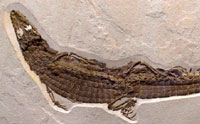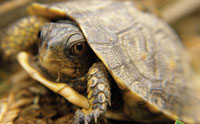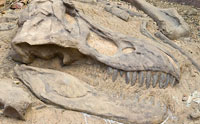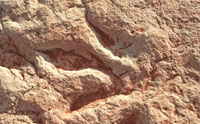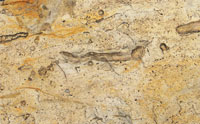The continents cannot be billions of years old because they would have eroded away long ago; there should be nothing left. …read more Read more here: creation.com
A new look at its potential to advance Flood geology. …read more Read more here: creation.com
Horses and fish don't usually hang out together, but apparently they died together. How did they end up in the same fossil bed? More… …read more Read more here: icr.org
Feathers are ruffled in the evolutionary community because the newest candidate for the world’s first bird upsets the currently popular claim that Archaeopteryx was not a bird at all. …read more Read more here: AIG Daily
Eunotosaurus already had the organization of leg and breathing muscles unique to turtles, inferred by muscle attachment points seen on its fossilized bones. More… …read more Read more here: icr.org
Rock salt formations are often thought to be formed from evaporated seawater. …read more Read more here: creation.com
The fossil find in China now confirms that fish appear suddenly in the fossil record along with all the other kinds of animals. …read more Read more here: creation.com
Preserved in Lark Quarry’s mid-Cretaceous rock are almost 4,000 individual tracks representing about 180 dinosaurs. …read more Read more here: AIG Daily
They can ignore the fossils, ignore protein decay, or claim contamination. But all three tactics create far more problems than they solve. More… Read more here: icr.org
Danny R. Faulkner, AiG–U.S., examines the Dodwell hypothesis, that the earth underwent a catastrophic impact in 2345 BC that altered its axial tilt and then gradually recovered by about 1850. Read more here: AIG Daily
Claims about the ‘oldest-ever amber fossil’ yet found just don’t stack up. If these tiny creatures evolved from some common arthropod ancestor, then one would surely reasonably expect that the fossil record should show a variety of transitional forms from that arthropod ancestor to today’s gall mites. However, when scientists recently described some of the earliest gall mites from these fossils, they found the contrary. The ancient gall mites look just like modern ones. Study lead author David Grimaldi said, “they’re dead ringers for (modern) gall mites.”7 Read more here: creation.com
Retreating Stage formation of gravel sheets. Read more here: creation.com
Newly described prints bolster biblical creation's explanation of dinosaur footprints. More… Read more here: icr.org
As the earth settled down after the dramatic events of the Flood—and before ice built up at the poles—we find evidence that some forests sprang up in Antarctica. Read more here: AIG Daily
An international team of scientists have uncovered graphic evidence of the deadly terror unleashed on a herd of dinosaurs as they were buried under sediment by the rising waters of Noah’s Flood in western Inner Mongolia (figure 1).1 Dinosaur bones were first discovered at the site, located at the base of a small hill in the Gobi Desert, in 1978 by a Chinese geologist. After about 20 years, a team of Chinese and Japanese scientists recovered the first skeletons, which they named Sinornithomimus, meaning “Chinese bird mimic”. A few years later in 2001, the international team excavated the remains of [More]
How do we investigate specific geological features from a biblical Flood perspective? Read more here: creation.com
Should sediba overshadow Lucy, or are both pretenders to the throne in human origins? Read more here: AIG Daily
An explanation for the origin of gold deposits has long eluded and perplexed prospectors and geoscientists alike, but one new study may have unlocked just the right clues. More… Read more here: icr.org
Bird fossils do not generally ruffle paleontologist's feathers, but some amazing specimens from China's Jehol province—preserving eggs inside fossil bird bodies—might do just that. More… Read more here: icr.org
Creationist earth scientist Shaun Doyle discusses some of the differences. Read more here: creation.com
A conundrum for ‘deep time’. Read more here: creation.com
Are we to believe that a whopping 505 million years' worth of mutations and natural selection have performed no alterations to acorn worms? More… Read more here: icr.org
For the last 15 years, Dr Mary Schweitzer has been rocking the evolutionary/uniformitarian world with discoveries of soft tissue in dinosaur bones.1 These discoveries have included blood cells, blood vessels, and proteins like collagen. But under measured rates of decomposition, they could not have lasted for the presumed 65 million years Ma since dino extinction, even if they had been kept at freezing point never mind the much warmer climate proposed for the dinosaurs.2 As she said in a popular TV show: When you think about it, the laws of chemistry and biology and everything else that we know say [More]
A team of researchers gave a presentation at the 2012 Western Pacific Geophysics Meeting in Singapore, August 13–17, at which they gave 14C dating results from many bone samples from eight dinosaur specimens. All gave dates ranging from 22,000 to 39,000 years, right in the ‘ballpark’ predicted by creationists.1 But if dinosaurs really were millions of years old, there should not be one atom of 14C left in them. Two of the report’s physicist co-authors … are urging colleagues to do their own carbon dating of dinosaur bones. This was a joint event of the American Geophysical Union (AGU) and [More]
Analysis and critique. Read more here: creation.com
For a hundred years, this evidence of rapid burial in recent history has been right under evolutionists’ noses—yet even now they still claim these crinoid fossils are 350 million years old http://researchnews.osu.edu/archive/oldbiomarkers.htm crinoids by David Catchpoole Published: 19 March 2013 (GMT+10) The photograph at right appeared in an Ohio State University press release, with the following caption: “Different species of the sea animals known as crinoids display different colors in these 350-million-year-old fossils. Ohio State University researchers have found organic compounds sealed within the pores of these fossilized animals’ skeletons. Photo by William Ausich, courtesy of Ohio State University.”1 Now, [More]























